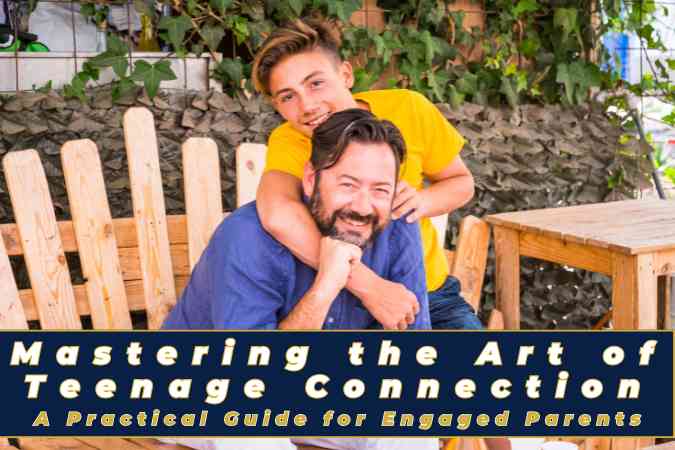Mastering the Art of Teenage Connection is possible. Navigating the teenage years can feel like walking through a minefield for many parents. But what if I told you that these years could actually be some of the best in your parenting journey? It’s time to flip the script on how we approach parenting teenagers.
As a father and former youth minister with over 20 years of experience working with young people, I’ve learned that building trust and open communication with teens isn’t as impossible as it might seem. In fact, it’s all about how we show up as parents.
Let’s dive into eight principles that can transform your relationship with your teenager and keep those communication lines wide open.
Never Stop Evolving
The first step to connecting with your teen is to adopt a growth mindset yourself. When you demonstrate a commitment to personal growth, you’re setting a powerful example for your teenager.
How to do it:
- Read books on parenting and personal development
- Listen to podcasts or watch videos that help you improve your skills
- Share what you’re learning with your family
Why it works: By modeling ongoing growth, you’re giving your teen permission to learn, fail, and stretch during some of the most turbulent times in their life.
Practice Extreme Ownership
This principle, popularized by former Navy SEAL Jocko Willink, is about taking full responsibility for everything in your life – including your teen’s behavior and your relationship with them.
How to apply it:
- When issues arise, ask yourself, “How could I have impacted this outcome differently?”
- Look for ways you could have planned better, taught clearer, or been more present
Why it’s effective: Owning every choice and misstep builds massive credibility in the eyes of your teenager. It also teaches them to take responsibility for their own actions.

Eye to Eye, Heart to Heart for Teenage Connection
Physical positioning matters more than you might think. When communicating with your teen, make an effort to be at eye level with them.
Put it into practice:
- Sit down if they’re sitting
- If standing, find a way to be at the same eye level
- Open up your stance to create a welcoming posture
Why it works: This non-verbal cue breaks down the “lecture mode” barrier and signals that you’re having a conversation with them, not at them.
Teenage Connection Requires Being Genuinely Interested
Your teen is a unique individual with their own thoughts, feelings, and passions. Show genuine curiosity about their world.
How to show interest:
- Ask open-ended questions about their interests
- Listen actively when they talk about their passions
- Engage with their world, even if it’s not your cup of tea
Why it matters: When teens feel that you’re genuinely interested in their lives, they’re more likely to open up and share with you.
Give Respect and Have Boundaries
Respect is a two-way street. Treat your teen (and everyone else) with respect, but also set clear boundaries about how you expect to be treated.
Implementing respect and boundaries:
- Model respectful behavior in all your interactions
- Clearly communicate your expectations for how you should be treated
- Consistently enforce these boundaries
Why it’s crucial: When teens see you treating others with respect and maintaining healthy boundaries, they internalize these behaviors and are more likely to reciprocate.
Teenage Connection Requires Establishing Clear Rules
Having a set of clear, fair, and consistent rules provides a sense of security for teens, even if they don’t admit it.
Setting effective rules:
- Make sure everyone in the family knows the non-negotiable rules
- Apply consequences equally and consistently
- Revisit and adjust rules as your teen matures
Why it works: Clear rules act as a security blanket in the chaos of adolescence, providing structure and predictability.
Embrace Transparency for Teenage Connection
Let your teen see the real you – flaws, doubts, and all. Being authentic builds trust and teaches valuable life lessons.
How to be transparent:
- Share your own struggles and how you overcome them
- Admit when you’re wrong or don’t have all the answers
- Let them see you problem-solve and recover from setbacks
Why it’s important: Transparency keeps the walls down and invitations open. It also teaches teens how to deal with life’s challenges.
Be Their Safe Harbor
Create an environment where your teen feels emotionally and mentally safe coming to you with anything.
Becoming a safe harbor:
- Practice strong emotional control – be slow to anger and react
- Base consequences on pre-established rules, not knee-jerk reactions
- Create a calm space for your teen to unload their worries
Why it’s critical: When teens know they have a safe place to turn, they’re more likely to come to you with problems before they escalate.
Implementing these eight principles won’t happen overnight, and it will take consistent effort. But the payoff – a strong, open relationship with your teenager – is worth every ounce of energy you put into it.
Remember, your teen wants you to be this kind of parent. They want you to lead the way and be engaged with them. It might be challenging at times, but it will be incredibly rewarding to watch your relationship grow and flourish.
So, which of these principles will you start implementing today? Your relationship with your teen – and your family’s happiness – is worth the effort. Here’s to moving from slammed doors and one-word answers to open, engaging conversations with your teenager.
TL:DR | Mastering the Art of Teenage Connection | TL:DR
- Never Stop Evolving
Commit to personal growth and learning to set a powerful example for your teenager.
- Practice Extreme Ownership
Take full responsibility for your relationship with your teen and their behavior.
- Eye to Eye, Heart to Heart
Position yourself at eye level to create a welcoming, conversational environment.
4. Be Genuinely Interested
Show curiosity about your teen’s unique thoughts, feelings, and passions.
- Give Respect and Have Boundaries
Treat your teen with respect and consistently enforce healthy boundaries.
- Establish Clear Rules
Provide a sense of security with a set of clear, fair, and consistent rules.
- Embrace Transparency
Let your teen see the real you, including your flaws and problem-solving skills.
- Be Their Safe Harbor
Create an environment where your teen feels emotionally and mentally safe.
Other Post You Might Like!






Recent Comments